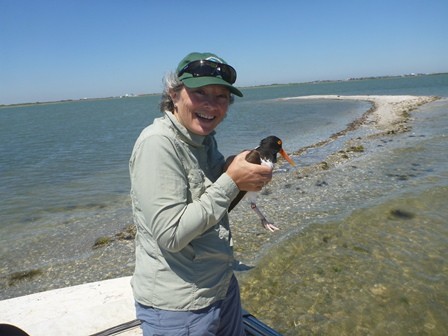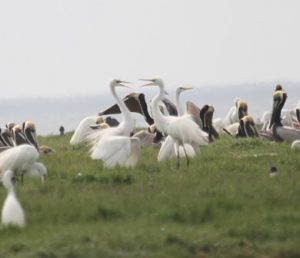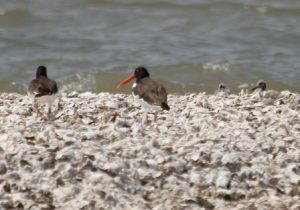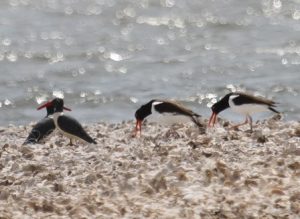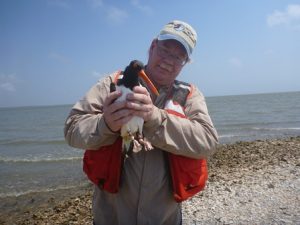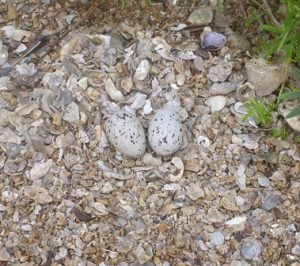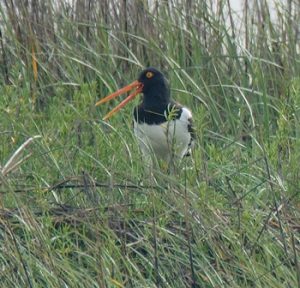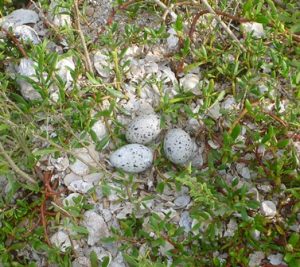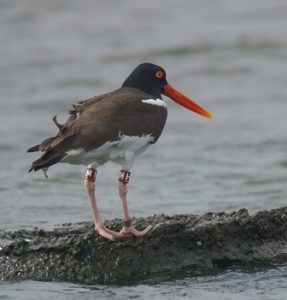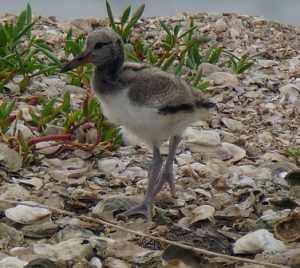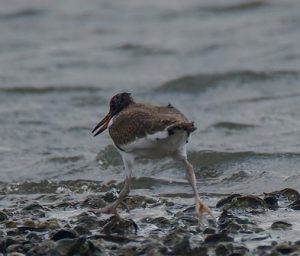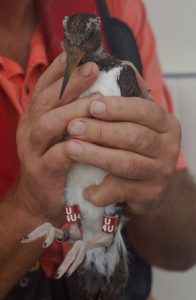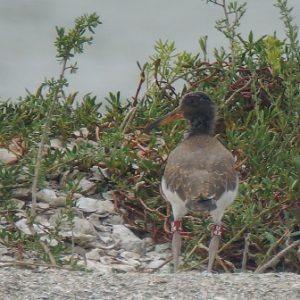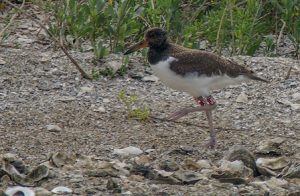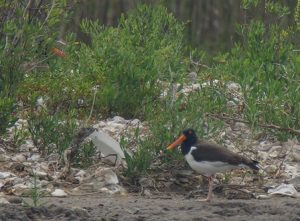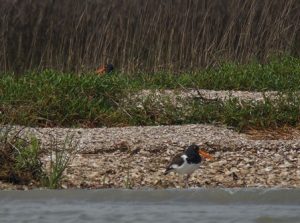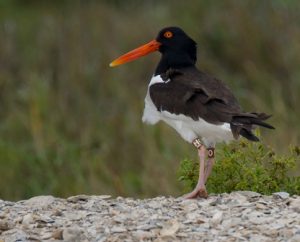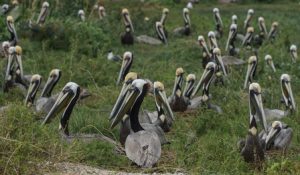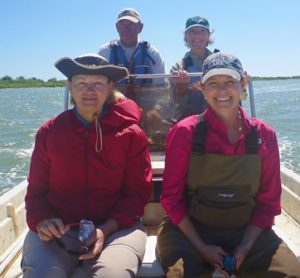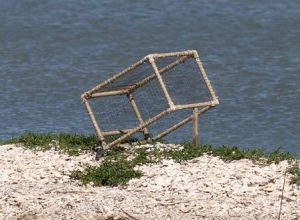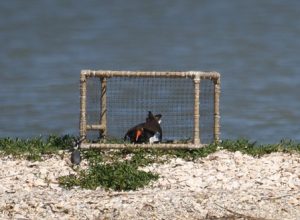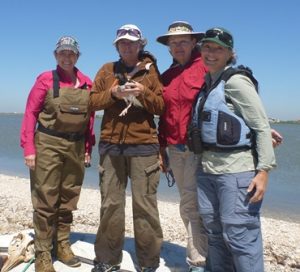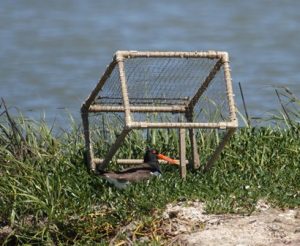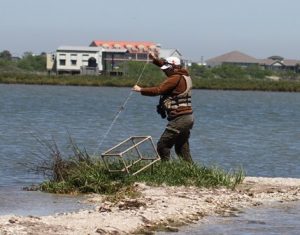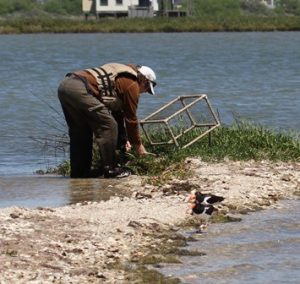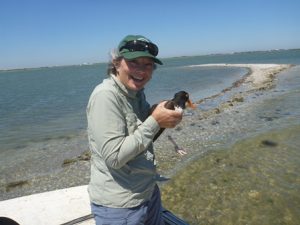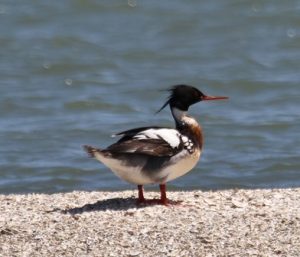By Susan Heath
On Monday I headed out to East Matagorda Bay with our new Executive Director, Martin Hagne, and jack of all trades volunteer, Oron Atkins. There wasn’t much wind for a welcome change and we enjoyed relatively calm waters for most of the day. We found that ER & unbanded had a new nest with two eggs.
This pair nests along the GIWW and any type of strong south wind seems to overwash their nests. This is their second try. Here’s hoping the winds hold off and they can be successful. The birds on Dressing Point are really starting to kick into gear. There are hundreds of egrets and herons there now all getting ready to breed.
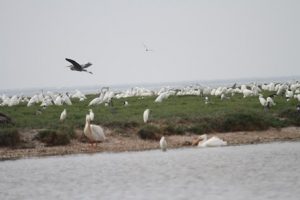 photo by Susan Heath
photo by Susan Heath
Here’s a pair of Great Egrets displaying to each other.
Over at the Oyster Farm I checked on KK’s nanotag with the handheld receiver and found that it was still transmitting. That’s a good thing! They also had a new nest with two eggs. The pair next door hasn’t renested yet though. We headed back across the bay and found that 17 & unbanded still have two chicks. Yeah! I wasn’t able to get a very good photo but here’s one of their little heads as they were hiding behind a shell bank.
None of the other pairs there had a nest so we went back and set up the noose carpets on an unbanded pair’s nest near Chinquapin. They flew to a neighboring island when we went on theirs to set up the nooses and we had to take the boat and go chase them back but once they flew over the decoys with the call playing, they landed and immediately got down to business trying to chase the intruders away.
We only had to wait about 10 minutes before one of them got tangled in the nooses. It was the female and she was one hefty girl. We banded her KN and Martin enjoyed holding his first oystercatcher.
We had to move our scheduled Wednesday trip to West Galveston Bay to Tuesday because of weather. John Wright took Alan Wilde, Oron and I out to check on all the birds up there. The wind. Oh the wind. The weather was only marginally better than predicted for Wednesday with winds in the high teens by the afternoon. Not my idea of fun. We made the best of it though and were able to check on all the pairs. The first bit of excitement came when we discovered that R3 & unbanded had a new nest on one of the small islands by the Tiki Island boat ramp.
When we got up to Swan Lake we found that K7 & unbanded were still hiding their chicks in the spartina. One of the adults was off getting food for the chicks and flying back to feed them until it noticed us passing by. Here’s K7 giving us some attitude.
We motored by without getting too close but that didn’t seem to matter to them. They came out and circled the boat calling anyway. Then we found that R5 & X3 also had a nest. Woohoo! Nests all around.
The wind had already started to pick up by the time we headed back to West Galveston Bay but we had a pretty smooth ride in John’s excellent boat. Our next stop was Struve Luci where the chicks were that we banded last week. I was anxious to see them and make sure they were ok. When we approached, I fired up the handheld VHF receiver and was able to pick up the signal from the nanotag we put on the chick. We didn’t see them on the back side of the island so we headed around the north end. There were found HM & unbanded and their two chicks.
Then we saw 12 on a reef. 12 & unbanded were one of the pairs that already had a chick when we went out in mid-February to check for nests but we hadn’t seen their chick in three weeks so I assumed something happened to it. Well something happened to it alright. It grew up undercover! Those sneaky rascals had a chick all along. Man they kept it hidden. I saw the little guy pop its head up from a shell ridge just as we were motoring by 12 on the reef. John pulled up as close as he could get to the island and I made chase. The chick tried its best to get away.
But I managed to snag it with the dip net just as it dove into the water. That’s a major move you have to learn when chasing down chicks! We banded it U4U. Cute little thing (but aren’t they all!).
All that excitement and we still hadn’t seen the two chicks we came to check on! Back underway, we headed for their area of the island and Oron spotted both of them standing up near the shell ridge. They both looked just fine!
Perhaps some bad news about the nanotag though. It is on that island and still working but I’m not convinced it is still on the chick. We couldn’t see the antenna at all and a review of Alan’s excellent photos shows that it is apparently not there. So much for my experimental attachment method for chicks. Obviously it needs some revision. More work to be done as usual. We didn’t see the chicks fly but they are at least 40 days old now and fledging occurs between 35 and 40 days, so they are officially the first fledges of the year. Maybe next week we’ll see them test their wings.
We left them all be and headed over to Jigsaw. T5 & T6’s nest had hatched and they were chasing off gulls. WW & unbanded were incubating their nest and YE & unbanded don’t appear to have gotten the memo that it’s nesting season. Then we motored over to check on 15 & 16 on the Galveston Island shore. They were still incubating which is great news. I’m really hoping that nest makes it. You can just see the incubating bird in the upper left of the photo.
We continued making the rounds and I checked to see if KK’s nanotag was still working (we put that one on last week). It was! We also found that JN & UW had a new nest. The one in the background is incubating.
Over on Marker 52 all the pairs were incubating their nests and we found that H0 & JC finally have one too! H0 is my favorite. He’s one of the first ones I banded and he’s been steadfast in his territory defense since I met him in 2011. He’s quite a character. Here’s he is.
He’s doing his best to defend his nest from this.
Those big feet are real egg crushers. We spent some time trying to trap an unbanded pair but they wouldn’t go close enough to the noose carpets so we gave up and went to check on the birds in Jones Bay. Big news there too. P3 & unbanded have a new nest! It only had one egg but P3’s unbanded mate was guarding it closely. Next week I expect they’ll have a full clutch and be incubating. They are almost always successful so I was disheartened when their first nest failed. Hopefully they’ll have better luck this time. We headed back to the safety of John’s dock then very glad to be out of the wind.
I had a couple days in the office and then on Friday Allan and Brigid Berger took me out to check on the pairs in the Port O’Connor area. Allan is on GCBO’s board of directors and Brigid is one of our oystercatcher monitoring volunteers. She monitors pairs in the west end of Matagorda Bay and in Espirito Santo Bay. We were joined by volunteers Suzanne Helm and Ursula Price.
I wanted to put out two nanotags there since we have good coverage from the Motus towers. It was windy as usual but Allan is a boat captain extraordinaire so it wasn’t a problem. We searched around a while to find some unbanded pairs but ended up having to go back to the area where we’d banded birds last year. The first pair had a nest and the unbanded bird was incubating so we set up the box on the nest.
We only had to wait about 10 minutes before the bird went in and the box tripped.
We banded that one KJ and I put the first nanotag on it.
The next pair had a nest too but the banded bird was incubating. Drat. When I went to check the nest though, the unbanded one was hanging around really close so I decided to give it a try. Because of the wind, we couldn’t see very well but we could tell the bird was up by the box. Finally it looked like it was laying down but the box didn’t trip. Drat again! We motored up slowly and noticed the bird was laying half in and half out of the box.
What the heck? I went up to see what was going on and discovered the bird had moved the fake eggs over and had actually been laying on them! That’s never happened before. I put the eggs back in the scrape and turned the box a different direction so it would have a hard time moving them without tripping the box. While I was doing that I noticed some fishing line entangled in the vegetation there so I took the time to remove it so they wouldn’t get tangled in it at some point.
And all the while I was doing all that the birds were right there!
Once we got far enough away the bird went right up, went in the box and tripped it! We banded that one KL and I put the second nanotag on it. Really glad to have those two tags out!
We found one more nest and were able to catch a bird on that one too. Here’s Brigid with the last catch of the day.
One of the advantages of being out on the water is all the other wildlife you get to see. We see dolphins a lot but I can never get any photos of them. We saw this beautiful male Red-breasted Merganser hauled up on an island and I was able to get his photo.
Thus ended another week of oystercatcher monitoring. The birds are doing really well so far. I hope it keeps up and we don’t have any bad weather events to thwart their efforts.
We’ve had a great response to the Adopt-an-Oystercatcher program! Thank you to everyone who has adopted a pair of birds. I will be sending out updates at the end of every month and sometimes in between if something exciting happens with the pair you adopted. If you aren’t familiar with the program – you can adopt a pair of oystercatchers for a $100 donation and I will update you monthly on their progress throughout the breeding season. Most pairs are from West Galveston Bay, but there is a pair from Dickinson Bay and a pair from Swan Lake too. Once I get out to East Matagorda Bay, I will add some from there.
Current Stats for upper Texas coast from Dickinson Bay to East Matagorda Bay: 20 nests being incubated, 7 failed nests, 6 nests with unfledged chicks, 0 nest with undetermined status, 2 chicks fledged
This project is supported by the National Fish and Wildlife Foundation and several private donors. If you would like to contribute you can do so by clicking on the Donate Now button below. All donations are tax deductible and GREATLY appreciated.

